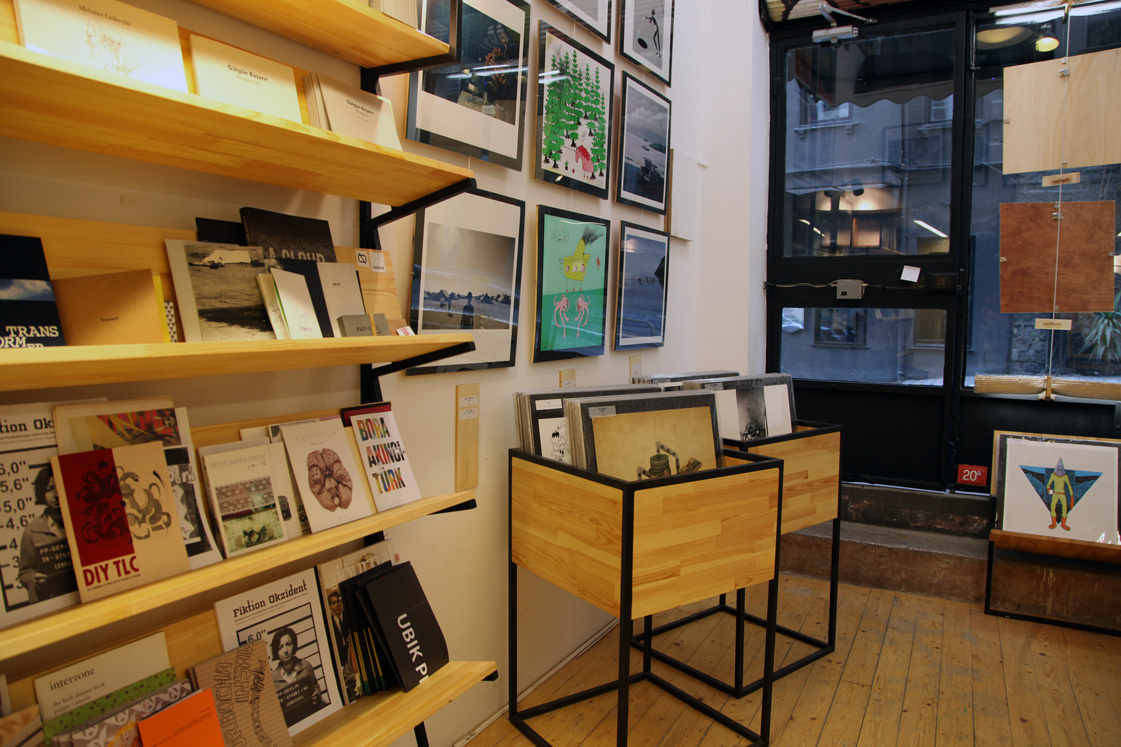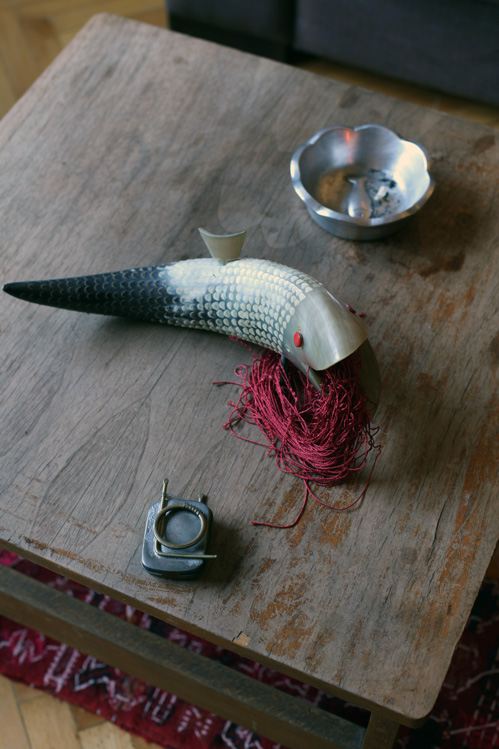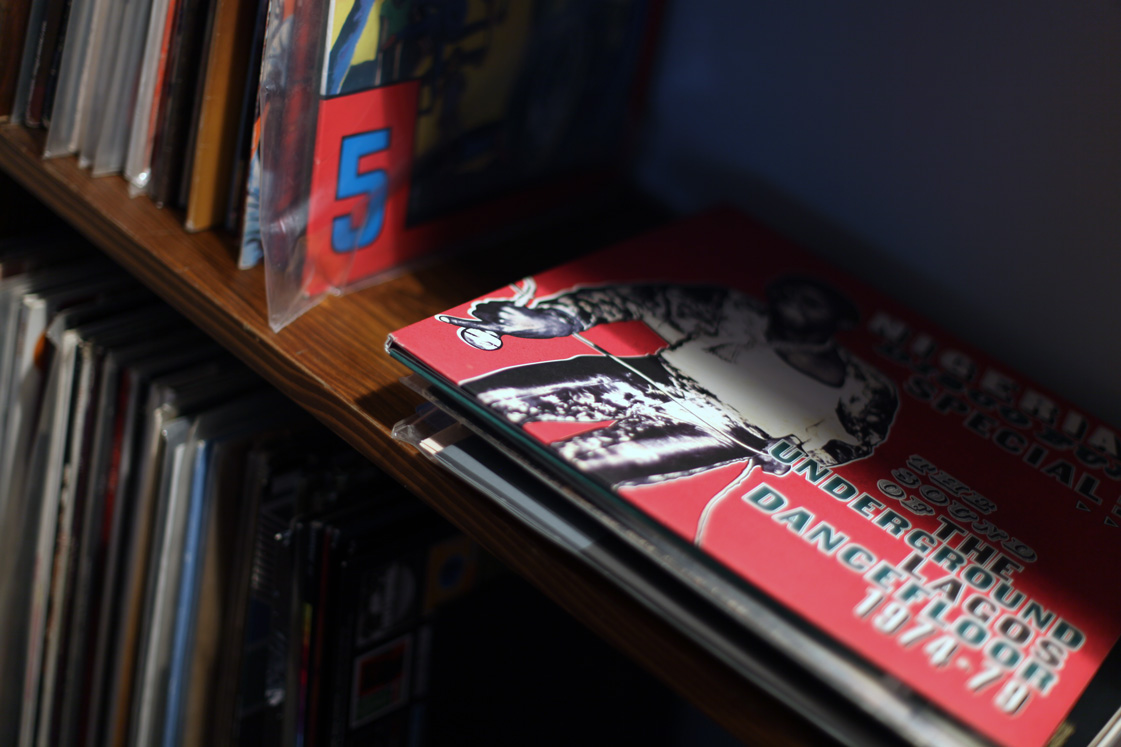Çağlar is the kind of person who never paid attention to the well-meant advice “one thing at a time, man”. Luckily, he didn’t otherwise Istanbul’s nightlife and art scene would have been a good deal poorer.
In 2009, he set up Mini Müzikhol with a whole bunch of friends, a location that was meant to be a nice hangout for friends, a place for “good old deprived souls and wanderers of music”. Within the shortest time Mini evolved to the number one address among Istanbul’s hungry youth and became an integral part of the local art and music scene.
At daytimes Çağlar takes care of his very heart piece of work. Together with Yetkin Basarir he runs the exhibition space Edisyon, a platform for young and upcoming artists that experiments with alternative ways of representation.
Located next to the former Egyptian embassy, an old raddled wooden mansion, Çağlar’s apartment serves as an agglomerate of the full spectrum of the oddity and beauty Istanbul has to offer. The walls are covered with artworks of friends; on the table a remarkable selection of German beer mats is piled up and on the balcony you find a disco ball right next to the Turkish flag of his neighbor.
When we arrive at his place a delicious Sunday brunch is set up and after the first cup of coffee the absence of last nights sleep is forgotten and a day among friends starts…

































You are involved in so many different projects. How would you define what you are doing?
Well I thought about it many times and came up with the word “facilitator”. I studied engineering and business administration and I always liked creating models and systems. I don’t like the word entrepreneur. It sounds a bit more business oriented. So, I love involving in projects, coming up with ideas and solutions and executing them. It has been always like that. A lot of my friends told me to concentrate on something and I never really opposed to that but I always thought, yes you are right, but it does not work for me. I want things to move on quickly but they never do, so I took the risk to do many different things at the same time and actually became a patient person.
You are one of the founders of Mini Müzikhol. What makes Mini a special place in Istanbul’s club scene?
The whole project started three years ago. We had this blog called Etrafta in which we were just blogging about everything around us, things that interested us. We were a very mixed group of people coming from arts, political science, graphic design and so on. We have been working on a project about a cultural center here. A place where we could have workshops, studios, galleries, with a food court and etc. But we couldn’t manage the financing of the project, so it didn’t work out. But during this project Minas (founder of Godet & soap-system) found this space and we decided to open up a neighborhood bar. It was a place for friends. We never did any PR, advertising or interviews, we never allowed photographers inside, and there were no cell phone reception inside. And although it became a very popular underground hot spot, we’re still trying our best to keep it real.
How would you describe the nightlife in Istanbul?
It’s mixed. There are hundreds of bars around Beyoglu area and I always wonder what’s going on inside. It takes a lot of courage to check out every single one of them. But still I can take you to some real freaky places. Overall, there are some posh celebrity clubs around the Bosphorus, which are rather show-up places. Then you have these tavern styled places that are cool to a point. Other then that, we have a very limited underground scene and all kinds of different scenes that belong to certain areas spread around the city. In terms of Beyoglu area, you can start at a meyhane and have raki with meze, move on into a pavyon (a kind of cabaret club) and just watch the people around, continue to a türkü bar and listen Turkish or Kurdish live music, and hop into a cab and end up at Mini. A night in Beyoğlu will surely be entertaining; full of adrenalin and the best part is that you never know what’s going to happen next.
You lived in New York for a couple of years?
Yes I did. My first visit to New York was because of a flight delay and I had six hours to spend in the city and visit a friend of mine. From the first moment, I felt home there. I was living in Florida back then and had enough of the suburban life and I had to get out of there. After I moving to NYC and after seeing the big picture there, I started thinking differently. There, I initiated most of the projects I’m now executing.
But you decided to come back to Istanbul?
Because I was running out of cash (laughs). Well at one point I thought I had to stop that lifestyle. I don’t regret it but it was just going on and on and New York felt like this big black hole sucking me in. So I came to Istanbul and saw the same black hole here again and thought damn it’s never gonna stop (laughs).
But then you started to set up the Mini MüzikHol project and the Artist Space Edisyon. Was there a conscious turning point?
It happened naturally I should say. We knew exactly what was missing in Istanbul and what people were expecting but still it took us days and nights of discussions to come up with a good and working model. We worked together with two architects and did a complete renovation in the space. The graphic design and all musical programming were made within our group and Minas and I we traveled all around Istanbul to find the right furniture. We were very specific about what we were looking for and that helped us a lot.
What are the Pro’s and Con’s of being involved into the nightlife business?
Well the best thing is that finally you get to drink for free. Also, I always loved hosting people at my apartment. I genuinely feel good when I have friends over and it really helped me to have a much bigger space with a better sound system.
The hardest part is also the same. Dealing with more people. More people means more problems, more complaints… Each night something happens, little issues but you have to respond to each one of them and it takes too much time and effort.
How did you end up opening Edisyon?
Well from my childhood on I have always been interested in arts and in gallery spaces. Of course when I was a kid I had no intentions to buy art works or own them. I just liked the spaces. It is the same with museums and libraries. I’ve always loved the ambience. So when I moved back to Istanbul, I started to working at different art collectives, attending artist talks and soon I started representing Bora Akıncıtürk. It’s because of Bora, I got into the art world. I am a curious person in nature and I was wondering what was going on in the galleries and the local art scene.
I wanted to create a system that can be part of the art scene but still works outside the circle. So, I came up with this project named “Mikro Galeri”. It is like a mini gallery in the size of a one-meter-square with wheels so that it could travel around in Istanbul. You could approach it from every side and have a small exhibition within that space. That project never happened and Yetkin had this graphic design studio and he was telling me that we should to something together and it evolved into what is today Edisyon. Edisyon is not a typical art gallery in that sense. It is a print gallery for artists where their works are accessible to the public. Most of the contributors are not very well known and the prices of the prints start from the same price preventing hierarchy among them. It could be considered as a micro economy model as well. We aim to create a win-win situation for both sides.
Why did you refuse to open up a classical art gallery?
The model we founded was also something we needed and that made a lot of sense. And also it was something we were good at: a big network of young artists and the know-how of digital printing. So, we knew that the combination would be something we wouldn’t fail and it would help our community at the same time. Dealing with constantly growing numbers of contributers/artists was a problem, but so far it is going well.
You are also a photographer. Is that something that you got inspired by your work with other artists?
There is definitely inspiration coming from all these different people around me. I’ve been reading and studying on my own for a while. Just recently I started a workshop of Ahmet Elhan and it feels really good working with a master. But still, because of my hectic life, my progress is very slow. It is also the only thing I do alone where nobody else is involved in. It’s relaxing.
Would you say Istanbul is a supportive place when it comes to opening up spaces and realizing projects?
I think it is the same as in every big city. New York, London or Berlin… It is not easy to start something from scratch. Each has its own dynamics and you have to know every detail from people’s behaviors to local cultural differences to public transportation etc. Istanbul is different when it comes to flexibility and the movements within the city. The scenes are very concentrated and don’t move away from one district to another. Like for example in New York and in London every time I visit them, I see the migration of artists to different areas of the city. Within the last 6-7 years I saw this in Bushwick, Red Hook, and Gowanus in NYC, Dalston and Hackney in London. These are all multi-cultural areas and when you move in, there is always a space where you can fit in as an artist. However in Istanbul there are both cultural and infrastructural barriers for artists to move around in the city. Here cultural problems are mostly related with religion and it takes a lot of sacrificing and understanding between people and it is really hard to come to an agreement.
What do you like the most about Istanbul?
It’s the people. Istanbul has such a long history and so many different people came to the city, lived here and influenced it in many different ways. You meet people with all kind of roots. Then there is this irrationality surrounds us. Everyday there is something happens where you just don’t know what to think of and how to react to it. Sometimes it is sad and you hate it and other times it is super fun and surprising. It is an atmosphere of vitality and you gain a lot of positive input from that.
Could you imagine living in another city in Turkey?
I wouldn’t want to live in another city but I can see myself living in a village in the countryside. With a house somewhere on the Aegean coast, overlooking the mountains. I can see myself fixing things and building new models there too. It is much more easier to contribute in smaller places. When you live in a city like Istanbul you somehow feel like you are just drowning in it.
What was the biggest mistake you made in 2011 and what was the best thing you did?
Hmm, I can’t really remember a big mistake I made. The best thing I did in 2011 was definitely Bora Akıncıtürk’s exhibition. We had a really tough start but at one point the whole thing just started to work so smoothly and perfectly.
With whom did you work together and where was the exhibition taking place?
We worked with two curators, Kristina Kramer and Nesrin Tanç. Before meeting them we had two exhibitions confirmed with two galleries and we cancelled them both because of attitudes and intentions of the gallery owners. And Bora wanted to do the exhibition within a month, which was quite impossible in Istanbul’s art scene. But we did not give up, one day we packed up some 20 paintings in the trunk of my car and started seeing curators and galleries that we knew and on our last stop Kristina and Nesrin loved the way we showed up and everything about the works and immediately we found ourselves talking about the details. The exhibition took place at an old apartment at Suriye Pasajı. That was definitely the best thing I did in 2011!
Do you have a favorite Turkish saying?
I have a favorite saying but its Chinese. It says, “A man without a smiling face must not open a shop.” Well, I like people with a positive attitude, who have a smile on their face. Yes, people with a smile I love them.
What is a typical work day like for you?
I work 7 days most of the year and on a typical day I start off with a brief breakfast with coffee, reading the news. Then move on to my office and spend and hour on e-mailings and urgent issues. Then there is always some meetings I have through the day. (And it is very strange that my weekly schedule on a Sunday looks pretty much free but starting from Monday it starts to fill each day until Saturday night and it goes on…) In the evenings, I usually spend time with friends. When I go back home, I spend another hour or two on e-mailings and my personal projects.
What are the major changes you experienced within the last years in Istanbul?
I’m seeing more foreigners each year. There are more suburban developments around the city. More project housings. And as a result of this, the rail transit network is growing like crazy each year.
What are the tunes you like to listen to at the moment?
I have been listening rockabilly and garage rock sounds for a while. And some tunes I learned from my dear friend Mersenne of undomondo.com, such as James Ferraro, Daniel Bachman, Nicolas Jaar, Helado Negro and Roedelius/Schneider.
Thank you for the interview!
If you are in Istanbul don’t miss the chance to stop by Edisyon and you should definitely check out the line up at MiniMüzikHol.
Interview: Antonia Märzhäuser
Photography: Ege Okal
